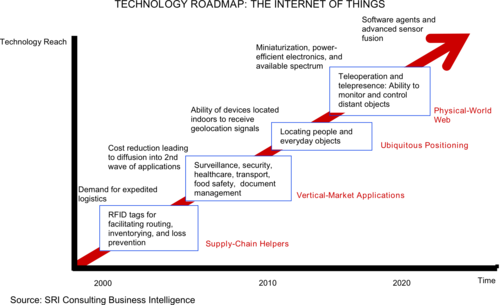
When did life get to be so easy?
Several years ago, if you want to shut the TV off you had to do it manually.
Several years ago, two or more subscribers shared a single telephone line (some sort of social networking? )
Several years ago, Morse code was used to send messages.
Several years ago, these changes in technology were considered the most dramatic. However, the growing interaction in the modern world has got something more useful: the Internet of Things (IoT.)

The Internet of Things (IoT) is a unique code identified for a thing. This code is the virtual representation in an internet-like form. Conceptualized in 1999 by Kevin Ashton, the concept of IoT became widespread via the Auto-ID Center where Radio Frequency Identification (RFID) is required to run the Internet of Things.
The vision of the internet of things is to make the impossible possible. With the help of determined developers, and engineers Internet of Things is likely to become a race to discover all searchable things – any idea is a good subject to automate.
Hmm, are you thinking of wiring your philandering husband? Want to know who owns those smudge of lipsticks on his neck? Save some cash for the (soon-to-be) apps.
The Future is Clear. Any Thing can be Networked
Would you believe your luggage can now say, “I’ve arrived?” Though not literally, the Bag-claim travel application is an advancement of luggage tags. A user only needs an iPhone that has wireless receiver. This application is very useful especially for frequent travelers: you no longer have to worry about your luggages even if you leave the airport for a cup of coffee.
How about your eyes instead of fingers to write and send messages? That will come by year 2013. A new technology designed by Danish developers targets the eyes to control and write messages. Aha! Sending messages no longer have to be with codes or fingers. Those Danish developers are now working in partnership with a suitable smartphone producer to make the application public.
According to John Weigelt, national officer at Microsoft Canada, anything can be networked. This is possible when computers, vehicles, appliances and houses begin talking. If you want something just push a button and that “something” suddenly appears. Hopefully, those handsome D.I.’s can be “ordered” in one press. Yayy!
Potential Downside
There are not millions but billions of things that can be networked in the world— via private intranets and the Internet. In 2008, internet users already exceed the number of people on earth. By year 2020, 50 billion smart phone users will be wired.
Do you think there is a potential downside to this techno-revolution? There’s lots, however, the most innovative, the smartest tech guys are working round the clock – expect a robot in every home by 2020.
No comments:
Post a Comment